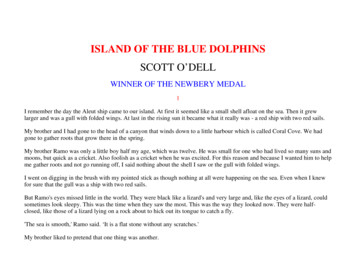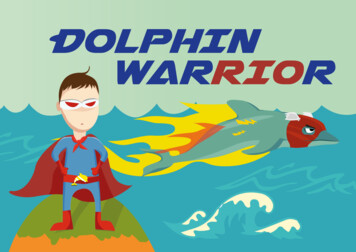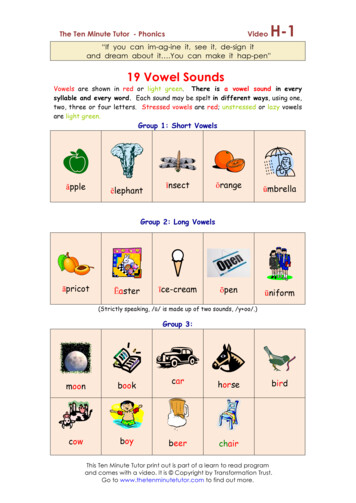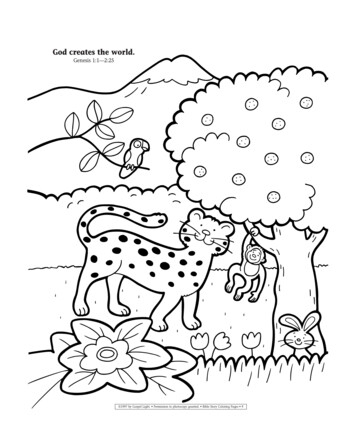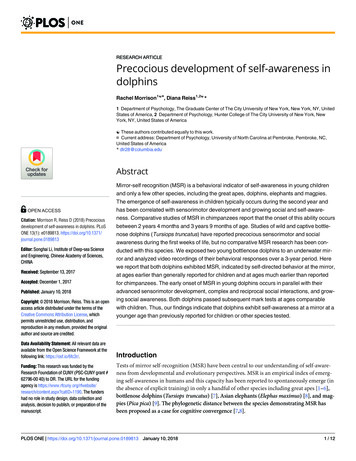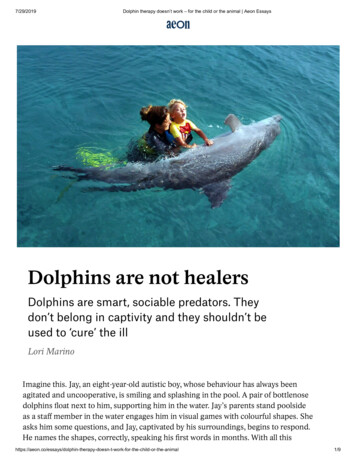
Transcription
7/29/2019Dolphin therapy doesn’t work – for the child or the animal Aeon EssaysDolphins are not healersDolphins are smart, sociable predators. Theydon’t belong in captivity and they shouldn’t beused to ‘cure’ the illLori MarinoImagine this. Jay, an eight-year-old autistic boy, whose behaviour has always beenagitated and uncooperative, is smiling and splashing in the pool. A pair of bottlenosedolphins float next to him, supporting him in the water. Jay’s parents stand poolsideas a staff member in the water engages him in visual games with colourful shapes. Sheasks him some questions, and Jay, captivated by his surroundings, begins to respond.He names the shapes, correctly, speaking his first words in months. With all -work-for-the-child-or-the-animal1/9
7/29/2019Dolphin therapy doesn’t work – for the child or the animal Aeon Essaysattention Jay is in high spirits; he appears more aware and alert than ever before. Aquick, non-invasive EEG scan of his brain activity shows that it is indeed differentfrom before the session.Jay’s parents, who had given up hope, are elated to have finally found a treatment thatworks for their son. ey sign up for more sessions and cannot wait to get home andtell their friends about the experience. ey are not surprised to find that dolphinshave succeeded where mainstream physicians have not. Everyone believes thatdolphins are special — altruistic, extra gentle with children, good-natured. And anyconcerns the parents might have had about the welfare of the dolphins have beenallayed by assurances from the trainers that they are happy and accustomed to therole they are playing. After all, as the parents can see for themselves, the dolphins aresmiling.‘Jay’ is a composite character drawn from the dozens of testimonials that appear ondolphin-assisted therapy (DAT) websites, but stories like his, stories about theextraordinary powers of dolphins, have been told since ancient times. Much of ourattraction to these creatures derives from their appealing combination of intelligenceand communicativeness, and the mystery associated with the fact that they inhabit ahidden underwater environment. Dolphins are the Other we’ve always wanted tocommune with. And their ‘smile’, which is not a smile at all, but an anatomical illusionarising from the physical configuration of their jaws, has led to the illusion thatdolphins are always jovial and contented, compounding mythological beliefs that theyhold the key to the secret of happiness.The mythic belief in dolphins as healers has been reiterated down the ages fromthe first written records of encounters with these animals. In Greco-Romantimes, dolphins were closely linked with the gods. Delphinus was a favouritemessenger of Poseidon, who repaid him for his loyalty by placing an image of adolphin in the stars. e Greek poet Oppian of Silica declared around 200 CE that‘Diviner than the Dolphin is nothing yet created.’ Aristotle was the first to recognisethat dolphins are mammals. Indeed, the root of the word dolphin, delphus, meanswomb, and underscores the long-standing belief in an intimate (even chimeric)connection between dolphins and humans.In ancient Rome and Mesopotamia, dolphins adorned frescoes, artwork, jewelleryand coins, and in ancient Greece the killing of a dolphin was punishable by death. eMinoan palace of Knossos on Crete, dated to 1900—1300BC, contains one of theearliest and best-known ornamentations depicting dolphins in a fresco on the wall ofthe queen’s bathroom. In Greek mythology, Taras, son of Poseidon, was said to -work-for-the-child-or-the-animal2/9
7/29/2019Dolphin therapy doesn’t work – for the child or the animal Aeon Essaysbeen rescued from a shipwreck by a dolphin sent by his father, hence the image of theboy on a dolphin depicted on historical coinage.e perception of dolphins as lifesavers is connected with beliefs that they possessmagical powers that can be used for healing. e ancient Celts attributed specialhealing powers to dolphins, as did the Norse. roughout time, people as far apart asBrazil and Fiji have traded in dolphin and whale body parts for medicinal and totemicpurposes. Despite being saddled with these dubious supernatural attributes, thereactually are several well-substantiated modern reports of dolphins coming to the aidof humans. In 2007, for example, a pod of bottlenose dolphins saved the surfer ToddEndris, who had been mauled by a great white shark off Monterey, by forming aprotective ring around him, which allowed him to get to shore. But these instances arerelated to dolphins’ ability to generalise their natural anti-predator behaviours toanother species, not to anything supernatural.e intelligence and sophistication of dolphins is not just mythological, of course.Decades of scientific research has confirmed that they possess large and highlyelaborate brains, prodigious cognitive capacities, demonstrable self-awareness,complex societies, even cultural traditions. In 2001 my colleague Diana Reiss and Iprovided the first definitive evidence for mirror self-recognition in two bottlenosedolphins at the New York Aquarium. Published in the Proceedings of the NationalAcademy of Sciences, this study demonstrated, along with many others since, thatdolphins have a level of self-awareness not unlike our own.Yet in the face of this evidence for their very real brainpower, dolphins have beenimbued with religious and supernatural qualities and remade into the ultimate NewAge icon.Margaret Howe spent 10 weeks living with a dolphin namedPeter in a tank rigged up to contain just enough water forthe dolphin to swim in and for Howe to wade ine person most responsible for fuelling modern, New Age notions of dolphins asmorally superior spiritual healers is the late neuroscientist John C Lilly, whopioneered research with captive dolphins in the 1960s. Lilly’s early work on dolphinbrains and behaviour, conducted in laboratories in the US Virgin Islands and inMiami, was groundbreaking, bringing to light important knowledge about thespecies’ large, complex brains and keen intelligence. Lilly also provided evidence fordolphin sophistication in the realm of communication, reporting that dolphins couldmimic the rhythm of human speech esn-t-work-for-the-child-or-the-animal3/9
7/29/2019Dolphin therapy doesn’t work – for the child or the animal Aeon EssaysIn a paper published in Science in 1961, Lilly reported in detail on the range of ‘vocal’exchanges between two dolphins in adjacent tanks, each equipped with a transmitterand receiver — Lilly’s dolphin ‘telephone’ — and noted how their ‘conversation’followed polite rules; for example, when one ‘spoke’, the other was quiet. Lilly drewup a dolphin lexicon showing that dolphins used a variety of communicationmethods, from blowing and whistling to clicking. Convinced that dolphins had asophisticated language of their own, he suggested that the species might provide thekey to unlocking humanity’s potential to commune with extraterrestrials. He becamepart of the initial SETI (Search for Extraterrestrial Intelligence) group of radioastronomy pioneers, who were so impressed with his tales of dolphin intelligence thatthey voted to call themselves ‘ e Order of the Dolphin’.However, Lilly and his followers eventually began mixing their own quasi-spiritualbeliefs with their scientific work. ey also began engaging in scientifically andethically questionable research, including giving captive dolphins doses of LSD. Inone ethically dubious experiment dating from 1965, Lilly’s research assistantMargaret Howe spent 10 weeks living with a dolphin named Peter in a tank rigged upto contain just enough water for the dolphin to swim in and for Howe to wade in.Within weeks, it became clear that Peter was less interested in Howe as a room matethan as a conjugal mate, and to stave off his increasingly aggressive behaviour, Lillyencouraged Howe to relieve the dolphin’s erections.Lilly’s claims about the superior nature of dolphin spiritual and moral qualities soaredwell beyond any legitimate data. ‘We can presume that they have ethics, morals andregard for one another much more highly developed than does the human species,’he wrote in e Dyadic Cyclone (1976). On the back of this conviction, he attempted toset up a formal but overly expansive programme of interspecies communication andco-operation between humans and dolphins called the Cetacean Nation, which was,needless to say, never fully realised.Despite (or perhaps because of) his controversial activities, Lilly became a countercultural guru and was very influential in promoting the use of dolphins in captiveresearch. His informal studies of dolphins interacting with autistic children led him tomake outrageous claims about the psychic powers of dolphins, which have sincebecome the basis for many pseudoscientific claims made by DAT facilities.Dolphins and whales were first captured for public display by the circus mogul PT Barnum, who kept wild-caught beluga whales in an aquarium at his museumin New York City in the 1840s and ’50s. en, as now, dolphins did not survive well incaptivity, yet the popularity of dolphin displays, in which trainers engaged ork-for-the-child-or-the-animal4/9
7/29/2019Dolphin therapy doesn’t work – for the child or the animal Aeon Essaysincreasingly daring aquatic gymnastics, grew dramatically, especially in the 1960s and’70s.A key influence here was the US television series Flipper, dubbed an ‘aquatic Lassie’and originally broadcast in 1964. It featured a bottlenose dolphin who lived in a coveand helped his human pals — two boys, named Sandy and Bud — to save people frommortal danger. But if Flipper was a boon to captive displays and increased publicdemand for dolphins, it also sparked concerns over their welfare. Marine parksresponded swiftly by rebranding themselves as centres of education, research andconservation, rather than just entertainment. And the shows continued.e public’s enthrallment with dolphins and whales drives enthusiasm for aquariumsand theme parks to this day. In the US alone, more than 50 million people visitcaptive facilities every year. Dolphin and whale shows have become increasinglyextravagant, involving many different species, acrobatic interactions between trainersand animals and set designs to rival a Broadway show. Swimming with dolphins(SWD) programmes have emerged as a critical, and lucrative, component of thedolphin entertainment industry. Although some commercial operations offeropportunities to swim with wild dolphins, most SWD customers swim with captivedolphins in the convenience of concrete tanks. ese SWD programmes emerged inthe 1980s, and while there were just four SWD programmes in the US in 1990, nowas many as 18 facilities offer dolphin ‘encounter’ programmes of one kind or another.Many people describe their in-water encounter with a dolphin as one of the mostexhilarating and transformative experiences they’ve ever had — even the highlight oftheir life. Others report feeling a sense of euphoria and intimate kinship with thedolphins, little doubting that this feeling is shared by the dolphins. In many ways, itwas only a matter of time before the concept of dolphin-assisted therapy emerged asan enhanced version of SWD programmes, underpinned, once again, by healingtheories derived from dolphin mythology, and by theme parks marketing themselvesas places of science and education.DAT took off in earnest when Lilly’s early explorations became better known throughthe efforts of the educational anthropologist Betsy Smith, then at Florida InternationalUniversity. In 1971, Smith let her mentally disabled brother wade into the water withtwo adolescent dolphins. She noted that the dolphins treated him tenderly: shebelieved that they knew her brother was disabled and were attempting to soothe him.Soon after, Smith established therapy programmes at two facilities in Florida, andoffered them free of charge for many years. But she later concluded that DATprogrammes were ineffective and exploitative of both the dolphins and the t-work-for-the-child-or-the-animal5/9
7/29/2019Dolphin therapy doesn’t work – for the child or the animal Aeon Essayspatients, and in 2003 she publicly denounced them, calling them ‘cynical anddeceptive’.DAT typically involves several sessions either swimming or interacting with captivedolphins, often alongside more conventional therapeutic tasks, such as puzzle-solvingor motor exercises. e standard price of DAT sessions, whose practitioners are notrequired by law to receive any special training or certification, is exorbitant, reachinginto the thousands of dollars. It has become a highly lucrative international business,with facilities in Mexico, Israel, Russia, Japan, China and the Bahamas, as well as theUS. DAT practitioners claim to be particularly successful in treating depression andmotor disorders, as well as childhood autism. But DAT is sometimes less scrupulouslyadvertised as being effective with a range of other disorders, from cancer toinfections, to developmental delays.Thousands of families visit DAT facilities and end upgaining nothing that they could not have gained frominteracting with a puppyWhile not always promising a cure, DAT facilities clearly market themselves asoffering real therapy as opposed to recreation. Under minimal standards, authentictherapy must have some relationship to a specific condition and result in measurableremedial effects. By contrast, DAT proponents cite evidence that is, more accurately,anecdotal, offering a range of explanations for its purported efficacy, from increasedconcentration to brainwave changes, to the positive physiological effects ofecholocation (high-frequency dolphin sonar) on the human body. Parents of autisticchildren and others who appear to benefit from DAT believe that these explanationsare scientifically plausible. e photos of smiling children and the emotionaltestimonials from once-desperate parents are hard to resist. Even those sceptical ofDAT’s scientific validity often just shrug and say: ‘What’s the harm?’ In the worst-casescenario a child who typically knows little enjoyment and accomplishment in life canfind joy, a little bit of self-efficacy and connection with others for what is sometimesthe first time in his life. But amid all the self-justification, the question most often leftout is: what about the dolphins?DAT facilities will often post testimonials from enthusiastic parents on their websites,some of which are recorded just minutes after the session ended, when parents arefeeling most hopeful. ese websites attract other parents who are desperate to findcures for their own children. ey come away impressed with the ‘evidence’ that DATcan improve their children’s lives, and the apparently scientific approach of the n-t-work-for-the-child-or-the-animal6/9
7/29/2019Dolphin therapy doesn’t work – for the child or the animal Aeon EssaysIt all looks so promising, and so they figure it’s worth the plane fares, the time offwork, and the high price tag.Meanwhile, many of the parents featured in the enthusiastic testimonials return hometo renewed disappointment. eir children fall back into their regular routine, and fallsilent again. At first, cognitive dissonance will not allow these parents to consider thepossibility that they’ve wasted their money. But later they recognise that nothing haschanged, and that the initial improvement was due to the excitement of the trip, andall the personal attention their child received. Many families visit DAT facilities andend up gaining little more than they would have done from interacting with a puppy.Equally sad are the lives of the dolphins. Hidden behind their smile, and thereforelargely invisible to patients and vacationers, captive dolphins spend their lives undertremendous stress as they struggle to adapt to an environment that, physically,socially and psychologically, is drastically different from the wild. e results aredevastating. Stress leads to immune system dysfunction. Often they die from gastriculcers, infections and other stress and immune-related diseases, not helped by theirsometimes being given laxatives and antidepressants that are delivered in their food.e worst of it, perhaps, is that there is absolutely no evidence for DAT’s therapeuticeffectiveness. At best, there might be short-term gains attributable to the feel-goodeffects of being in a novel environment and the placebo boost of having positiveexpectations. Nothing more. Any apparent improvement in children with autism,people with depression, and others is as much an illusion as the ‘smile’ of the dolphin.While there exist numerous published studies purporting to demonstrate positiveresults from DAT, none so far has controlled for feel-good and placebo effects. Mostdon’t even include a minimal control group, which would provide some measure ofwhether even general short-term feel-good effects are due to the dolphin or to othersalient factors, such as being in the water, being given conventional tasks, gettingincreased attention from others, and so forth. Because none of these components ofthe DAT situation are disentangled, there remains no credibility to the claim that DAToffers effective therapy.DAT clients are often among the most vulnerable members of society, so the industrytakes advantage of them. e pseudoscientific patina and untested testimonials serveto reel in desperate parents and people suffering with severe anxiety or depressionwho will do anything to get some relief. ey are persuaded by words such as‘treatment’ and ‘therapy’ and by the misuse of scientific methods, such as EEG tomeasure brainwave patterns, which suggest scientific doesn-t-work-for-the-child-or-the-animal7/9
7/29/2019Dolphin therapy doesn’t work – for the child or the animal Aeon Essayse consequences are potentially dire. Despite the mythology, dolphins can beaggressive. Even Lilly acknowledged that their teeth were sharp enough to snap a 6ftbarracuda clean in two. A number of participants in SWD and DAT programmes havebeen seriously harmed by these large, wild predators, sustaining injuries ranging froma ruptured spleen to broken ribs and near-drownings. In one example from 2012 atan Isla Mujeres resort, off Cancún, one of the dolphins in a SWD programme bit awoman who was on honeymoon. ‘I felt the dolphin had my whole thigh in his mouthand then I realised I had been bitten, and it was very painful,’ Sabina Cadbrand toldreporters when she got home to Sweden. Two other people were bitten in the sameincident, including a middle-aged woman whose wound went right down to the bone.ough it might not chime with New Age dolphin lore, the reality is that dolphins,even those born in captivity, are wild. Parents who would never place their child in acage with a lion or an elephant seem to think nothing of placing them at very real risk(of both injury and disease) in a tank with a dolphin. Only last year, an eight-year-oldgirl had her hand bitten at Sea World, Orlando, while feeding a dolphin.e public is largely unaware of the consequences, because aggressive or dyingdolphins and whales are often quietly replaced by others taken from the wild ortransferred from another facility. ough the original star orca whale Shamu spentjust six years in captivity in SeaWorld San Diego, dying in 1971, the name ‘Shamu’has been used for different orcas in shows ever since, leading to the perception thatthe original Shamu is alive and well and enjoying longevity in captivity.I’ve conducted research with many captive dolphins over the years, most of whichdied prematurely. Presley and Tab, the two young dolphins that starred in my mirrorself-recognition study, were later transferred to new facilities and perished shortlyafterwards. eir deaths were especially hard for me to rationalise, because my ownstudy had shown them to be self-aware creatures. ey convinced me, several yearsago, never to return to captive studies, and to channel the bulk of my energies intocampaigning for dolphin protection and freedom. I understand that desperate peoplewill continue to visit DAT facilities for help with their own illnesses. Sadly, they maynever realise that the dolphins they seek help from are likely to be as psychologicallyand physically traumatised as they are.Lori Marino is a neuroscientist and an expert in animal behaviour and intelligence.Formerly on the faculty at Emory University, she is the founder and executive director of theKimmela Center for Animal Advocacy in Utah, and president of the Whale erapy-doesn-t-work-for-the-child-or-the-animal8/9
7/29/2019Dolphin therapy doesn’t work – for the child or the animal Aeon Essaysaeon.co18 June, -work-for-the-child-or-the-animal9/9
dolphin in the stars. e Greek p o et Oppian of Silica de clared around 200 CE that ‘Diviner than the Dolphin is nothing yet created.’ Aristotle was the first to re cognise that dolphins are mammals. Indeed, the ro ot of the word dolphin, delphus, means womb, and underscores
